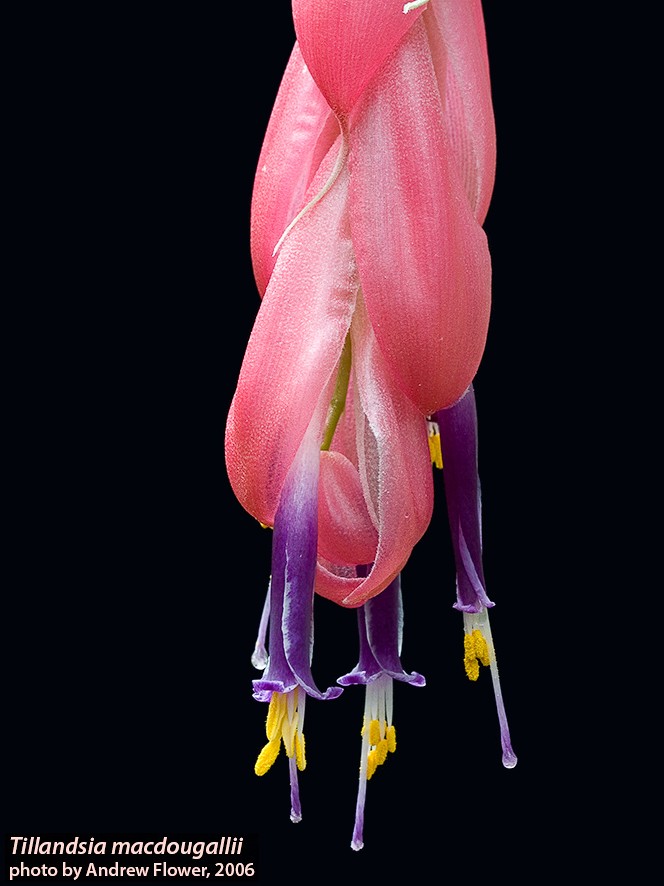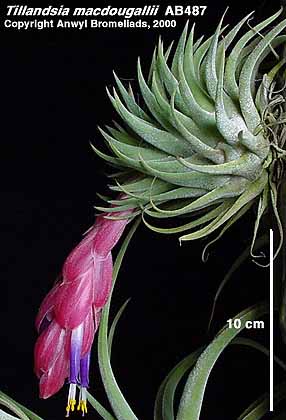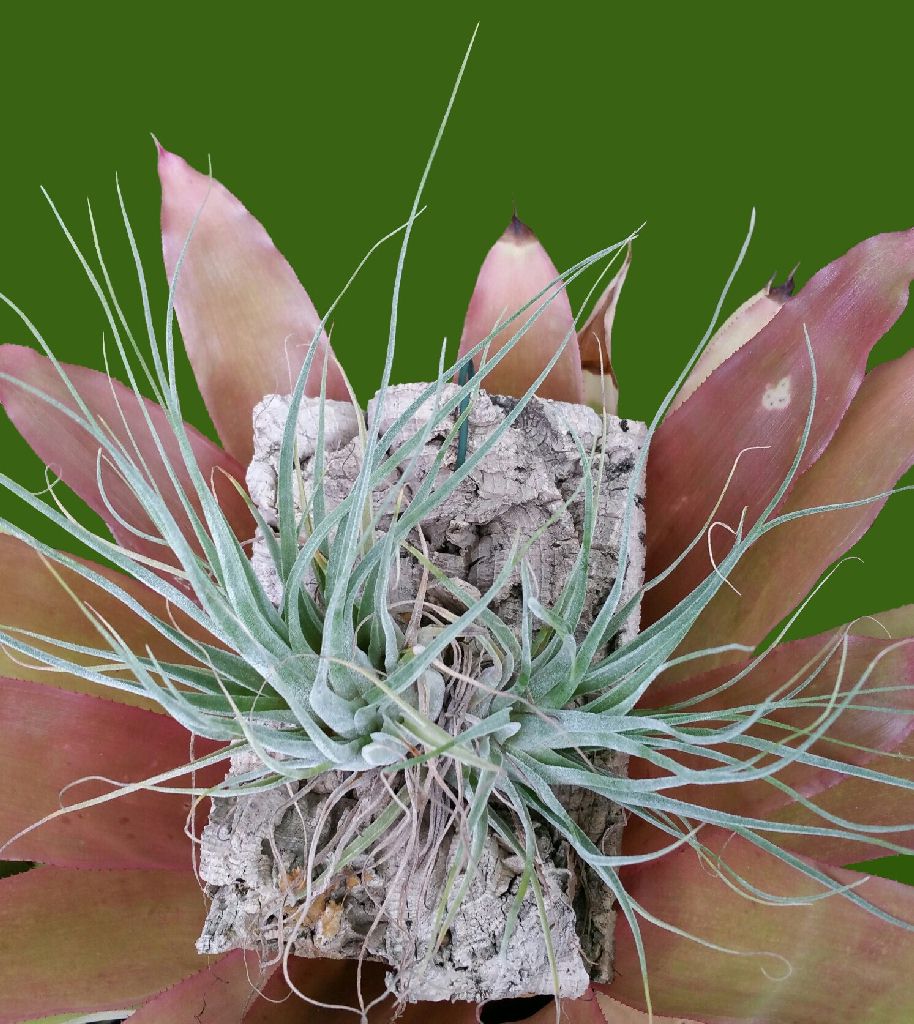



Stemless; leaves numerous, 15-20 cm. long, covered with cinereous spreading scales, the sheaths distinct, broadly elliptic, the blades narrowly triangular, caudate-acumiuate, 15 mm. wide at base; scape short and largely concealed by the leaves, curved; scape-bracts densely imbricate, elliptic with long foliaceous blades, membranaceous, roseate, densely lepidote; inflorescence simple with the flowers in several ranks, ellipsoid, 12 cm. long; bracts imbricate, the lower ones like the scape-bracts, the upper merely acute, all much exceeding the sepals; sepals subfree, broadly oblanceolate, acute, 35 mm. long, thin, densely cinereous-lepidote; petals erect, 6 cm. long, violet, stamens exserted.
Type in the U. S. National Herbarium, No. 1894930, collected at lower altitudes, at Lachatao, State of Oaxaca, Mexico, December 31, 1947, by T. MacDougall.
In its inflorescence and bracts, Tillandsia macdougallii closely resembles T. benthamiana Kl. and T. andrieuxii (Mez) L. B. Smith. It differs from T. benthamiana in its violet petals and from T. andrieuxii in its acute to caudate bracts. It is unlike either in its broadly oblanceolate densely lepidote sepals.
Desc from S&D p1011-2
Plant stemless.
Leaves numerous, 10-25 cm long, covered with cinereous spreading scales;
Sheaths distinct, broadly elliptic;
Blades narrowly triangular, caudate-attenuate, 15 mm wide.
Scape short and largely concealed by the leaves, curved;
Scape-bracts densely imbricate, elliptic with long foliaceous blades, membranaceous, roseate, densely lepidqte.
Inflorescence simple with the flowers in several ranks, ellipsoid, 8-17 cm long.
Floral bracts imbricate, the lower ones like the scape-bracts, the upper merely acute, all much exceeding the sepals.
Sepals subfree, broadly oblanceolate, acute, 35 mm long, thin, densely cinereous-lepidote;
Petals erect, 6 cm long, violet;
Stamens exserted.
Type. MacDougall s n (holotype US), Lachatao, Oaxaca, Mexico, 31 Dec 1947.
DISTRIBUTION. Saxicolous on rock faces and epiphytic in pine and oak forest, 18003200 m alt, Central Mexico.
MEXICO. NAYARIT: Cerro San Juan, Jalisco to El Malinal, 9 Jul 1957, McVaugh 15237 (MICH). JALISCO: Mamantlan, Autlan to Chante, 28 Ju11949, Wilbur 1905 (MICH, US); Cerro Viejo, Zapotlan de Hidalgo, south of Guadalajara, 28 June 1956, Gregory & Eiten 253 (MO, MICH); Cerro de Talcozagua, Tapalpa, 19° 57' N, 103° 45' W, Aug 1960, Iltis, Koeppen & Iltis 781-A (US); Sierra de Manantlan, 25-30 km southeast of Autlan, Mar 1965, McVaugh 23146 (IPMEX, MICH). HIDALGO: San Jeronimo, Tepeapulco, 21 Mar 1964, Rzedowski 18286 (US). VERA CRUZ: Mount Orizaba, Jul 1901, Rose & Hay 5779 (US). PUEBLA: San Manuel de la Sierra to San Andreas, 1938, Balls & Gourlay 4452 (K); Rio Frio, 30 Mar 1957, Foster & Van Hyning 2906 (US). MEXICO: 55 km southeast of Mexico City, 1942, Weaver 711 (US); Cerro Papayo, Rio Frio, 22 Feb 1953, Matuda 28233 (US). MICHOACAN: Cerro Santa Maria, 8-10 km southwest of Jiquilpan, Aug 1959, Feddema 167 (MICH). OAXACA: Nochixtlan, 14 Apr 1959, Van Hyning 5956 (US).
A Comparison of Tillandsia macdougallii with T. oaxacana
Renate Ehlers from JBS 1989 p 247 – 50, 272
For many years I wondered what Tillandsia oaxacana might be. Whenever I went to a botanical garden, a private collection, or to a commercial plant nursery I asked for T. oaxacana. Nobody but I seemed to have any difficulty with identifying this plant. Everybody thought that he owned T. oaxacana and was convinced that his plant was the real thing. All the plants, however, turned out to be T. macdougallii or related to T. matuda but with a distinct scape. They were all imported from Guatemala. None matched the description of T. oaxacana.
In her dissertation, Sue Gardner is dubious about the distinction between the two species and suggests that they should be investigated. Her drawing seemed to me to be Tillandsia macdougallii.
There are only two evident differences between the plants: Tillandsia oaxacana has adpressed-lepidote leaves and dark, castaneous sheaths. T. macdougallii has cinereous, spreading scales, and sheaths concolorous with the blades.
Tillandsia macdougallii is a very variable plant and in its home locations the sheaths are sometimes very dark. In cultivation, the plants become lighter in color and that may be why people have thought that they own T. oaxacana.
In studying the descriptions by L.B. Smith, I saw that MacDougall collected both of the type plants near Lachatao, Oaxaca, in Mexico: T. oaxacana on 21 December 1947 and T. macdougallii on 31 December of the same year. Dr. Smith described both plants in 1949. I could not believe that a botanist of his qualifications would have described two similar plants from the same locality. I was sure that there must have been significant differences.
In reading the description of Tillandsia atrococcinea Matuda (Cact. Suc. Mex. 22(1): 22-23, fig. 13; Oct.-Dec. 1977) I found that plant very similar to T. oaxacana and soon suspected that it might be the real oaxacana. Nobody except our friend Dr. Jurg Rutschmann believed me.
Since I wanted to solve the problem, I decided to go to the type locality and wrote to Dr. Smith for information. Only three days before leaving for our trip to Mexico in February 1988, Dr. Smith was kind enough to send a very good photo of the type of Tillandsia oaxacana and it became evident that T. oaxacana L.B. Smith is the same plant that Matuda described in 1977 as T. atrococcinea. Nevertheless, we wanted to go to the type location, to Lachatao.
We found the small village easily on the map of Oaxaca, between Oaxaca and Valle National, not very far from the main road. In reality it was not so easy to get there because, as it turned out, it was a very small place and nobody seemed to know where the road was. Twice we were directed to the wrong road and drove for hours. There were no houses, no one to ask and, of course, no signs. Finally, we decided that the map was wrong, but 15 kilometers are not very much in Mexico. We reached Lachatao in the late afternoon. It is a nice little village but in a dry area and neither Tillandsia oaxacana nor T. macdougallii could grow there. So we drove up to higher elevations. At the very last minute, just before the sun went down, we found Tillandsia macdougallii and T. violacea growing on the pine trees but could not find any T. oaxacana. A little disappointed, we returned to Oaxaca.
Sometimes it is funny where the type plants come from. Tillandsia macdougallii grows in so many places very close to the main roads in Mexico. Very big plants, with long, drooping inflorescences grow near Rio Frio, only one hour from Mexico City on the way to Puebla, and you can see them from the car. In Oaxaca, it grows near the main roads also. But MacDougall collected the plants in the Sierra of Lachatao, which seemed to us nearly at the end of the earth.
MacDougall was not the first one to collect Tillandsia macdougallii since Karwinsky as early as 1830 had collected that plant near S. Andres, Oaxaca, and had sent it to the herbarium in Halle (East Germany) (HAL 45541). Wilhelm Weber found the plant and made a drawing of it in 1980.
Although we did not find Tillandsia oaxacana at Lachatao, we were happy to find both it and T. macdougallii very near the main road between Oaxaca and Valle National. We also found both plants growing near each other between Tlaxiaco and Putla de Guerrero, both in the state of Oaxaca.
Comparison of the collected plants shows that Tillandsia macdougallii and T. oaxacana are very variable.
Tillandsia macdougallii L.B. Smith. Plants from near Orizaba or Rio Frio are very large, with long, pendent inflorescences and lanceolate floral bracts. Specimens from Oaxaca differ very much in that those from Lachatao are silvery with adpressed scales. When found in oak forests near Tlaxiaco, they are light green with very dark sheaths. In the same area at higher elevations and growing on pine trees they are very small, with white, pruinous scales, and short, eggshaped inflorescences. In the state of Durango in northern Mexico between Mazatlcin and Durango, they are similar to the type plants from Lachatao.
The plants we collected near Vallarta on a small road leading to a mine are nearly bulbous and the leaves secund. All of the material from these locations that I examined, despite the evident differences, fit the description of T. macdougallii.
Tillandsia oaxacana L.B. Smith also differs very much in size, structure of the leaves and inflorescence. It sometimes grows together with T. violacea. When the plants are not flowering it is hard to distinguish one from the other. T. oaxacana can also be very big, with very narrow, green leaves. Between Oaxaca and Puerto Angel we found small plants with more coriaceous leaves appearing grey because of the close-lying scales. The inflorescence can be nearly straight with very short stem, or descending with a distinct scape. The inflorescence may be ellipsoid or nearly cylindrical. Nevertheless, they fit the description of T. oaxacana L.B. Smith (syn. T. atrococcinea Matuda).
After all that, I was glad that I had solved the riddle.
As both species come from elevations of 1,600-3,500 m, they are not easy to cultivate. During the summer, when they are hanging in shady trees, there is no problem in the German climate. In winter, however, many bromeliad lovers have difficulties since they cannot keep the plants cool enough indoors. We have two glasshouses, one for cactus and cool plants that is heated only to 8 degrees Centigrade (about 40 degrees Fahrenheit) and we have no problems with the plants. They grow and flower pretty well since they like it cold. (Near Rio Frio we saw T. macdougallii covered with 15 cm of snow).